
5 Steps to Align Your IT Roadmap with Business Goals for Maximum ROI
October 24, 2025 / Bryan ReynoldsAligning the Compass: A 5-Step Plan to Ensure Your IT Roadmap Drives Business Goals
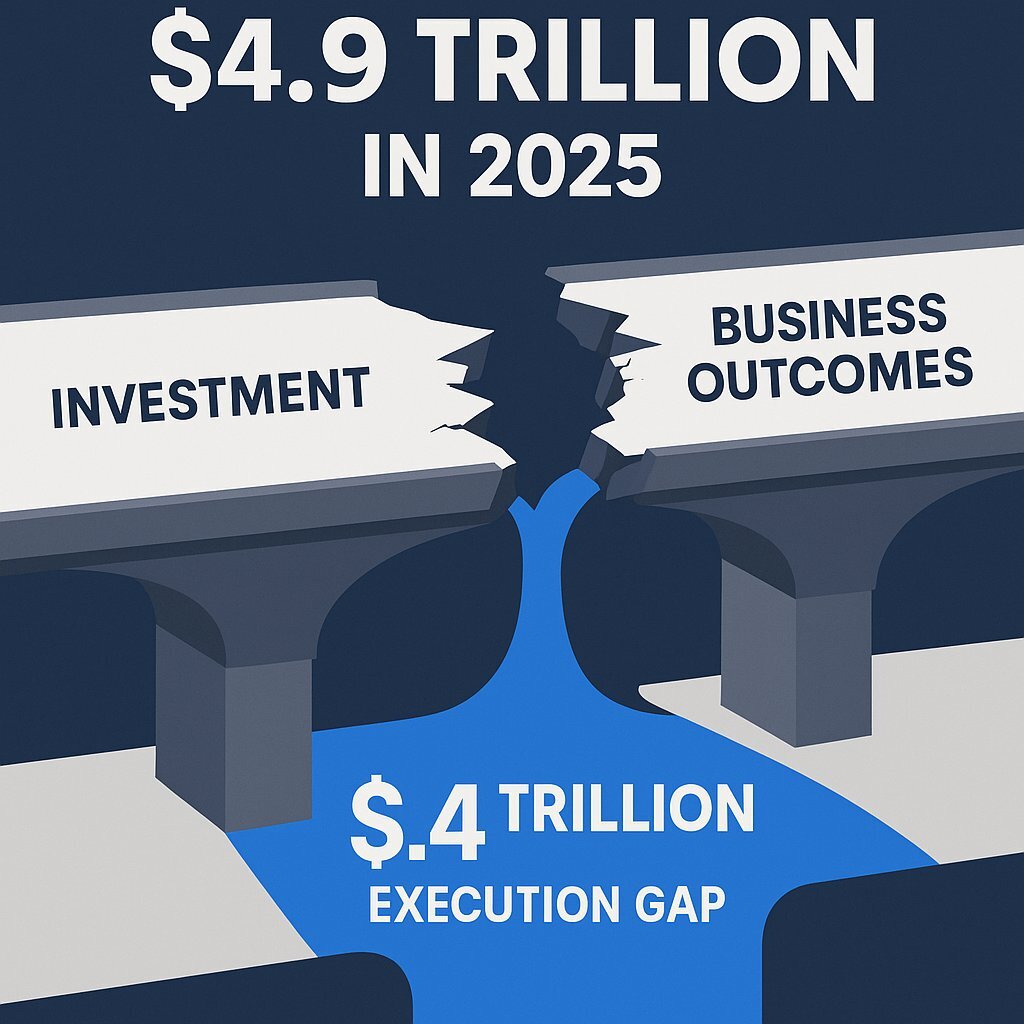
Part 1: Introduction: The $3.4 Trillion Execution Gap
In 2025, global information technology spending is projected to reach an unprecedented $4.9 trillion. This colossal investment represents the engine of modern enterprise, intended to fuel innovation, streamline operations, and create durable competitive advantages. Yet, a staggering execution gap looms over this expenditure. Analysis from McKinsey reveals that approximately 70% of all digital transformation initiatives fail to achieve their stated objectives, primarily due to a persistent lack of alignment between technology initiatives and core business goals. The financial implication is immense: a potential misalignment of nearly $3.4 trillion in capital, resources, and opportunity.
This is not a technical problem; it is a fundamental business challenge. For decades, many organizations have relegated the IT department to the role of a cost center, a support function mandated to simply "run faster, better, and cheaper". This ingrained perception has created a self-perpetuating cycle of strategic disconnect. When business leaders view IT as a transactional service provider—the "department of servers and laptops"—they exclude technology leaders from the crucial early stages of strategy formulation. Operating without this strategic context, IT departments are left to react to requests rather than co-create solutions. The resulting technology, while often functional, inevitably falls short of driving strategic business outcomes, which in turn reinforces the C-suite's initial perception of IT as a non-strategic function.
Breaking this cycle requires more than incremental improvements to project management; it demands a deliberate, C-suite-led cultural and operational shift. This report provides a clear, actionable five-step methodology designed to close the execution gap. It is a blueprint for transforming the IT function from a reactive order-taker into a proactive value creator, ensuring that every dollar of technology investment is a direct and measurable contribution to overarching business goals.
Part 2: From Engine Room to Bridge: The New Mandate for Technology Leadership
The evolution of IT from a back-office utility to a strategic business catalyst is no longer a theoretical trend; it is an economic reality. The pervasive digitization of every business process—from customer acquisition and supply chain management to employee experience—has placed technology at the absolute center of modern operations and market leadership. Forward-thinking organizations no longer treat technology investments as operational expenses but as strategic assets essential for growth and innovation.
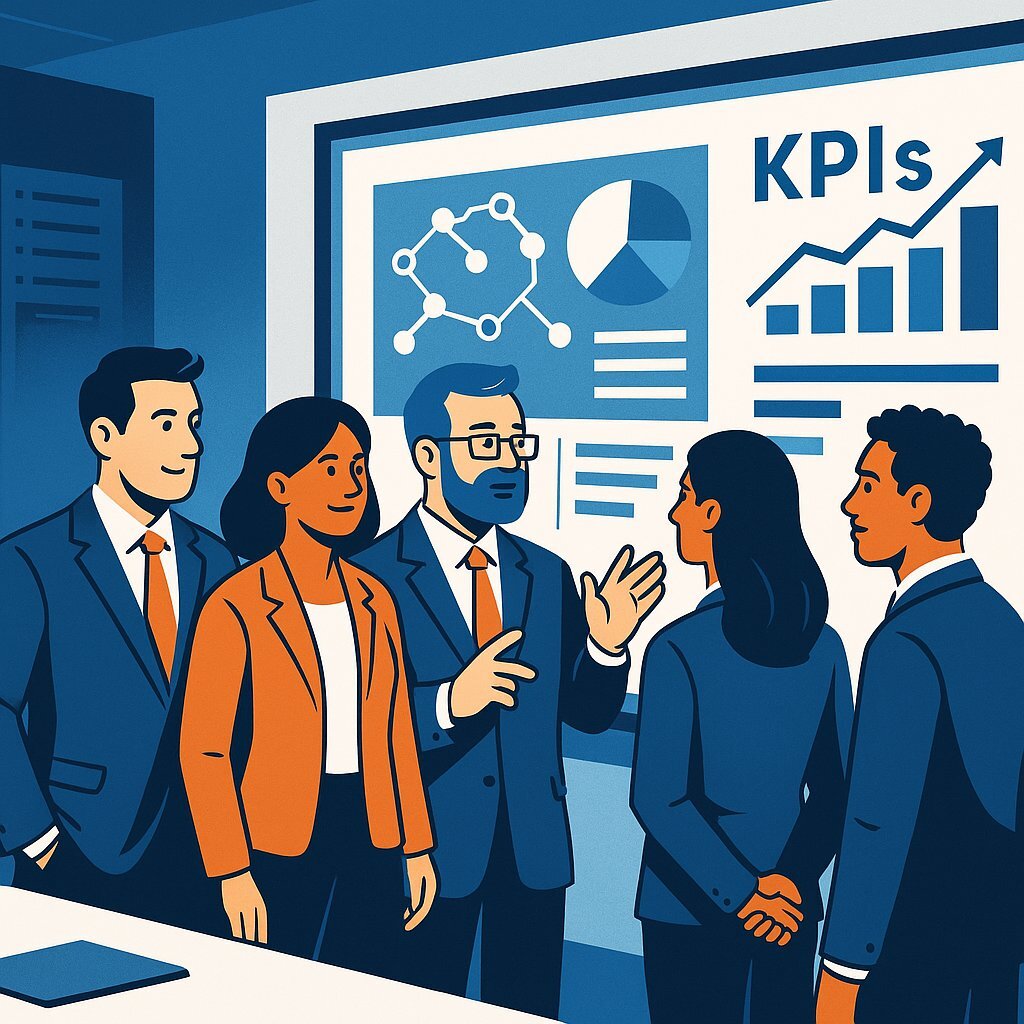
The business case for achieving this strategic alignment is not merely qualitative. It is backed by substantial data demonstrating a direct impact on financial performance and competitive positioning.
- Enhanced Profitability: Research from Deloitte shows that companies with tightly integrated IT and business strategies outperform their peers by a remarkable 20% in profitability.
- Market Leadership: A study published in the Harvard Business Review found that organizations fostering strong collaboration between business and IT are 2.5 times more likely to be market leaders in their respective industries.
- Increased Agility and Speed: The operational benefits are equally compelling. Data from McKinsey and Forrester indicates that strategically aligned teams bring innovations to market 25% faster and reduce project delays by up to 50%.
This transformation is evident across high-stakes industries. In finance , the digital strategies of institutions like JPMorgan Chase are not peripheral IT projects; they are core business imperatives. By migrating 70% of its data to the cloud, the bank fundamentally re-architected its operations to enhance customer service, improve efficiency, and build a platform for future innovation.
healthcare is experiencing a parallel revolution. For instance, aligning data-driven models and AI governance strategies helps healthcare organizations manage their digital assets securely, while driving meaningful advances like remote patient monitoring, AI-driven diagnostics, and smart hospital management systems—all of which directly improve patient outcomes and boost operational efficiency.
In the fast-paced gaming industry, the link is even more direct; aligning technology infrastructure—like automated deployment pipelines—with business goals for rapid feature delivery is critical to maintaining user engagement and preventing immediate revenue loss.
These examples reveal a critical truth for modern executives: the degree of alignment between an organization's technology and business strategies is a leading indicator of its future financial performance. The operational efficiencies gained—faster innovation, fewer delays, more impactful projects—are not just "nice to have." They are the direct precursors to higher profitability and sustained market leadership. Therefore, the state of an organization's IT-business collaboration deserves the same level of C-suite scrutiny as its sales pipeline, supply chain logistics, or capital allocation strategy.
Part 3: The 5-Step Plan to Forge a Business-Driven IT Roadmap
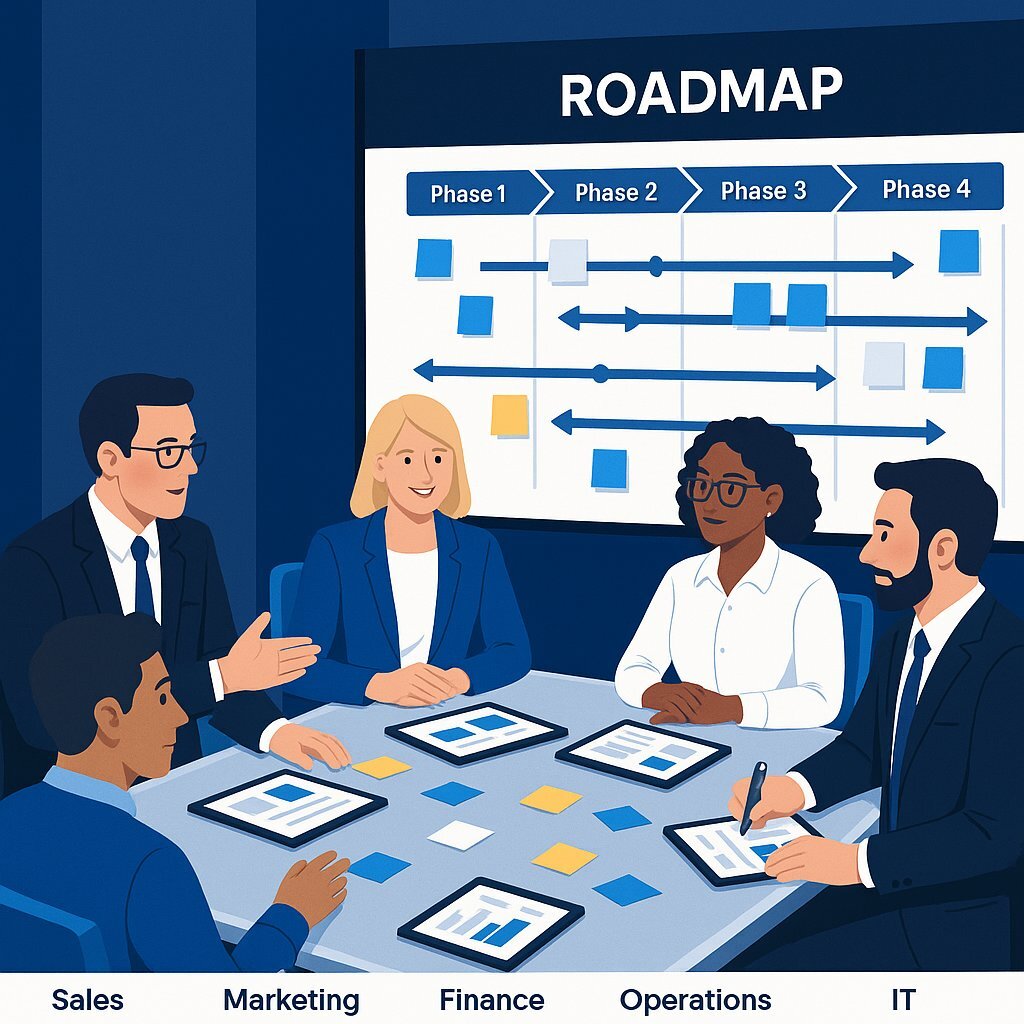
To bridge the gap between technology potential and business reality, leaders must adopt a structured, disciplined approach. The following five-step plan provides a framework for creating and maintaining an IT roadmap that is not merely aligned with business goals, but is a direct expression of them.
Step 1: Collaborative Roadmap Development: Beyond the IT Silo
The most common point of failure in strategic alignment is siloed decision-making, which forces IT into a reactive posture. The remedy is to treat the IT roadmap not as a technical document owned by the CIO, but as a strategic artifact co-owned by the entire executive team. This requires a fundamentally collaborative development process.
This process is a powerful mechanism for creating a shared understanding across the C-suite. By co-creating the roadmap, business leaders are compelled to articulate their strategic needs in a structured, forward-looking manner, while technology leaders are empowered to frame their initiatives within that business context. The roadmap itself becomes the "shared language" that is so often missing, transforming from a simple project schedule into a powerful tool for strategic communication and alignment.
Actionable best practices for this collaborative process include:
- Assemble a Cross-Functional Strategy Team: The roadmapping session must extend beyond the IT department. It should include the heads of Sales, Marketing, Operations, and Finance—stakeholders who possess direct knowledge of market dynamics, customer needs, and operational pain points.
- Begin with Business Objectives, Not Technology: The conversation must start with the organization's highest-level priorities. Is the primary goal to increase market share, improve customer retention, reduce operational costs, or enter a new geographic market? Every technology initiative discussed must be a direct response to one of these core business objectives.
- Establish a Shared Vision Through Structured Workshops: Facilitate dedicated sessions to align all stakeholders on the overarching goals and key initiatives for the coming 12-24 months. This high-level strategic alignment must be achieved before any discussion of specific software, hardware, or platforms.
- Ensure Transparency and Accessibility: The resulting roadmap should be a living document, not a static file. It must be widely shared and designed for clarity, using visual elements to communicate direction, priorities, and timelines effectively. This transparency is key to maintaining alignment as the plan is executed.
Step 2: Define Business-Centric KPIs: Measuring What Truly Matters
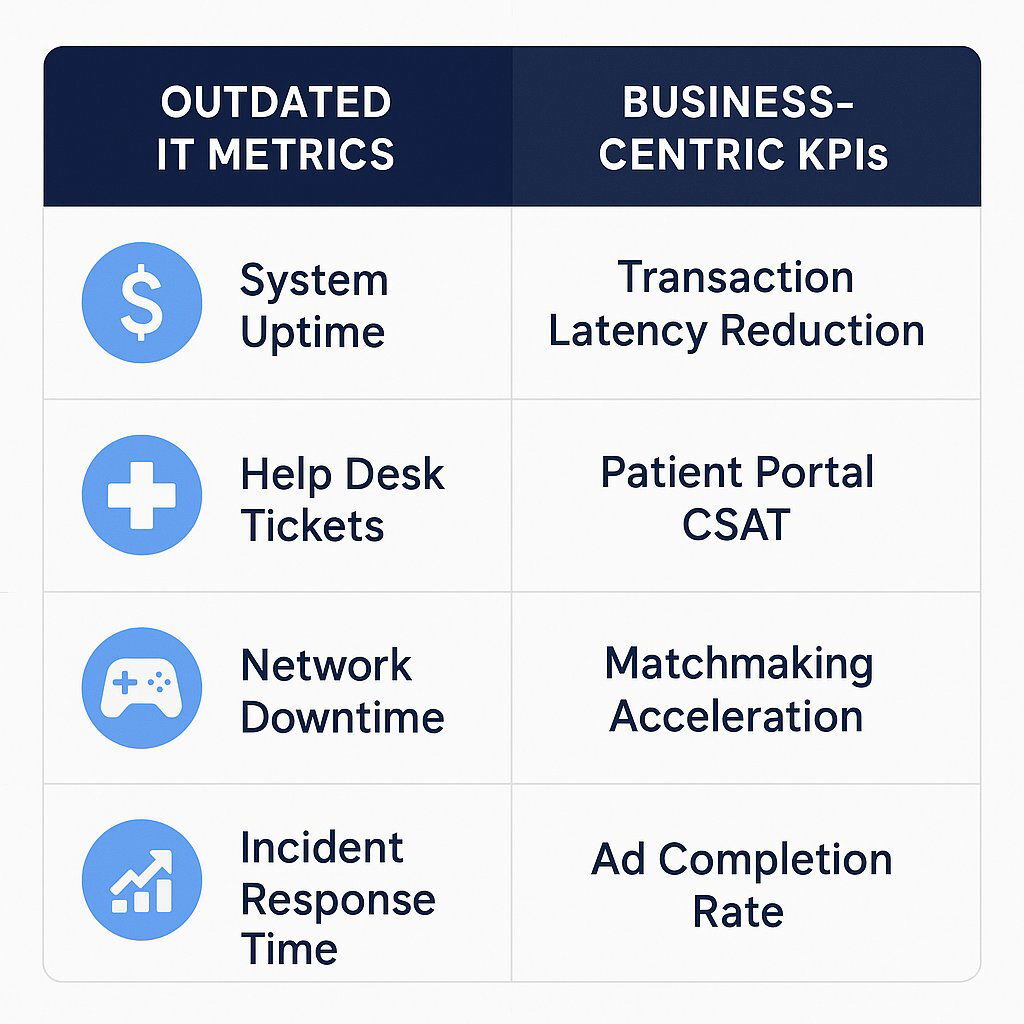
A primary reason IT is perceived as a cost center is its reliance on metrics that are meaningless outside the IT department. Metrics such as "system uptime" or "number of tickets resolved" measure IT effort, not business impact. To earn a strategic voice, technology leaders must adopt the language of the business, which means measuring and reporting on Key Performance Indicators (KPIs) that reflect tangible business outcomes. The goal is to shift the conversation from IT outputs to business results.
This requires a deliberate re-framing of how IT performance is evaluated. Instead of focusing on the health of the technology stack, the focus must be on how that technology stack improves the health of the business. This shift is demonstrated in the following table, which contrasts outdated technical metrics with strategic, business-centric KPIs across key industries.
| Industry Vertical | Outdated Technical Metric (Measures IT Effort) | Strategic Business KPI (Measures Business Impact) |
|---|---|---|
| Finance / FinTech | System Uptime: 99.99% | Transaction Latency Reduction: -15ms |
| IT Spend vs. Plan | % of IT Investment by Business Initiative (e.g., Digital Onboarding) | |
| Healthcare | Network Availability | Improvement in Patient Portal CSAT Score: +10% |
| Number of Help Desk Tickets Resolved | Reduction in Clinician Administrative Time via EHR Automation: -3 hrs/week | |
| Gaming | Number of Critical Bugs Fixed | Increase in Average Revenue Per User (ARPU) post-feature launch |
| Release Frequency | Reduction in Time-to-Market for New Content: -25% | |
| Advertising / AdTech | Data Storage Costs | Increase in Audience Segmentation Query Speed: +40% |
| Server Patch Compliance | Reduction in Ad Load Time: -50ms |
By adopting KPIs like these, technology leaders can clearly demonstrate how their initiatives contribute to revenue growth, customer satisfaction, and operational efficiency—the metrics that matter most to the CEO, CFO, and the board.
Step 3: Justify Investments with ROI: Speaking the Language of the C-Suite
Every significant technology initiative must be presented not as a cost, but as a business case with a clear and defensible Return on Investment (ROI). This requires translating technology benefits into the financial language of the C-suite, a critical step in overcoming the perception of IT as a mere expense category. To dive deeper into structuring ROI-driven discussions, you might consult our latest custom software budgeting guide for 2026, which offers strategic frameworks and practical tools for quantifying technology value.
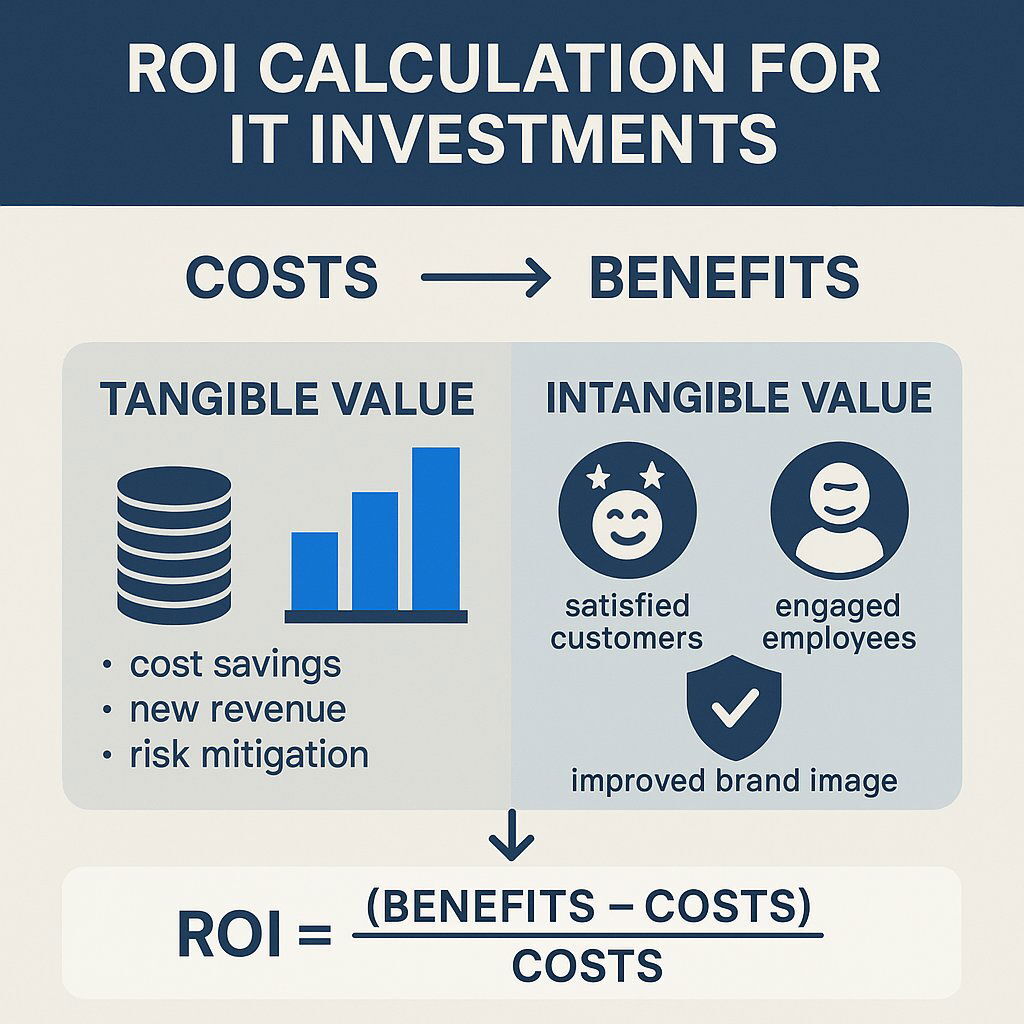
The standard formula provides a clear framework:
To apply this effectively to technology projects, leaders must be comprehensive in defining both sides of the equation:
- Project Cost: This must be an all-encompassing figure. It includes not only the initial development and implementation costs but also software licensing, hardware acquisition, employee training, and crucial ongoing maintenance and support expenses.
- Financial Value: This is the most critical component and requires a holistic view of the project's benefits. It must include both tangible returns that appear directly on the balance sheet and intangible benefits that have a clear, albeit indirect, financial impact.
- Tangible Benefits: These are the most straightforward to quantify and include new revenue generated from a digital product, direct cost savings from process automation (as seen in a PwC-led transformation that reduced a client's finance spend by 30% ), and risk mitigation, such as the avoidance of regulatory fines through improved compliance systems.
- Intangible Benefits: While harder to measure, these are often the most valuable. They include improved customer satisfaction, which drives higher retention rates and increases Customer Lifetime Value (LTV); enhanced employee morale and productivity resulting from better tools; and a stronger brand reputation built on superior digital experiences.
To build credibility and manage executive expectations, it is best practice to present ROI projections as a range, outlining a "Best Case," "Worst Case," and "Most Likely" scenario. This approach acknowledges inherent uncertainties and fosters a more transparent and trustworthy dialogue about the potential value of a technology investment.
Step 4: Communicate Continuously: Building a Narrative of Value
An aligned roadmap is a powerful start, but maintaining that alignment requires a disciplined and continuous communication strategy. A common mistake is to communicate only when asking for budget or reporting a problem. Strategic technology leaders build an ongoing narrative of value, ensuring that business stakeholders consistently see and understand the impact of their technology investments.
The foundational principle of this communication is that value is ultimately determined by the stakeholder, not the IT department. Therefore, all communication must be tailored to their specific priorities and perspectives. Effective communication with the C-suite adheres to several key practices:
- Lead with Business Outcomes, Not Technical Activities: Frame every update around the business result. Instead of stating, "We achieved 99.9% system uptime," the message should be, "Our platform's reliability supported a 7% increase in transaction capacity during the peak sales period".
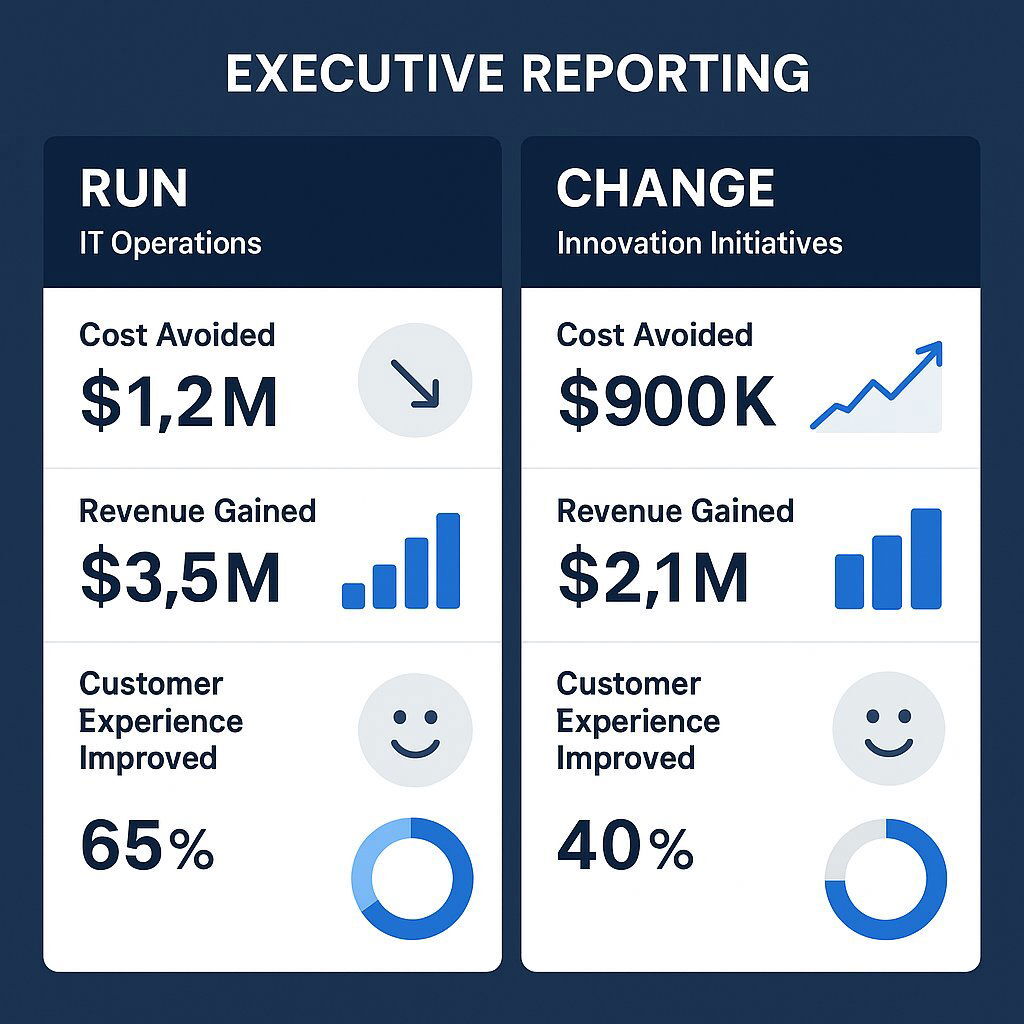
Executive-ready IT reporting: clean, business-focused, and jargon-free. - Speak the Language of Business: Rigorously avoid technical jargon. All discussions should be framed in the clear, unambiguous terms of revenue, cost, risk, and customer experience.
- Utilize Executive-Ready Visuals: Senior executives are time-constrained. Information should be presented in a highly digestible format, such as one-page executive summaries, simple before-and-after KPI dashboards, and high-level project timelines. The goal is to convey the essential information and its business implications in under three minutes.
- Separate the "Run" and "Change" Narratives: A sophisticated communication strategy distinguishes between the value of ongoing operations and the value of new initiatives. The value of "IT Run" (operations) should be communicated as a function of the ongoing business outcomes it enables. The value of "IT Change" (growth and transformation projects) should be communicated in terms of the new value it creates. This separation prevents the strategic importance of innovative projects from being diluted by the necessary costs of day-to-day operations.
The impact of this communication discipline is profound. Analysis from Gartner predicts that CIOs who successfully tie their operational ("Run") costs to specific business outcomes are 30% more likely to secure the funding they need for future initiatives. This establishes a direct link between the quality of a CIO's communication and their ability to resource their department for innovation and growth.
Step 5: Iterate and Adapt with Agility: The Modern Imperative
In today's volatile market, a static, five-year IT plan is a relic. The final, and perhaps most crucial, step in this framework is to embed agility into the very fabric of strategic planning. The IT roadmap must be a living document, capable of adapting to shifting market conditions, emerging competitive threats, and evolving customer expectations. The rigid, linear "waterfall approach" to planning is no longer sufficient, especially when compared to the proven flexibility of Agile.
Applying principles from Agile methodology, originally developed for software engineering, provides a powerful model for strategic management. This involves:
- Strategic Sprints: Breaking down large, multi-year initiatives into smaller, high-impact projects that can be executed, measured, and reviewed in short cycles (e.g., quarterly). This allows the organization to deliver value faster and learn from real-world results.
- Continuous Feedback Loops: Establishing regular cadences for reviewing the roadmap with cross-functional stakeholders. This ensures that the plan can be adjusted based on new data, whether from customer feedback, performance metrics, or shifts in the competitive landscape.
- Prioritizing Adaptability: Cultivating a culture where responding to change is valued more than rigidly adhering to the original plan. This mindset shift is essential for navigating uncertainty and seizing unforeseen opportunities.
Executing this agile vision, however, presents a significant challenge for many organizations, particularly those burdened by legacy systems and technical debt. For more on balancing adaptability and configuration, see our breakdown of the Configuration Complexity Clock and how to manage the risks of flexibility versus maintainability.
This is where a strategic partnership can be transformative. Firms specializing in modern development practices can provide the external expertise and development capacity needed to make an agile strategy a reality. To ensure long-term post-launch success and resilience as you adapt, we also recommend our software maintenance guide for executives, which includes a lifecycle approach to upkeep and evolution.
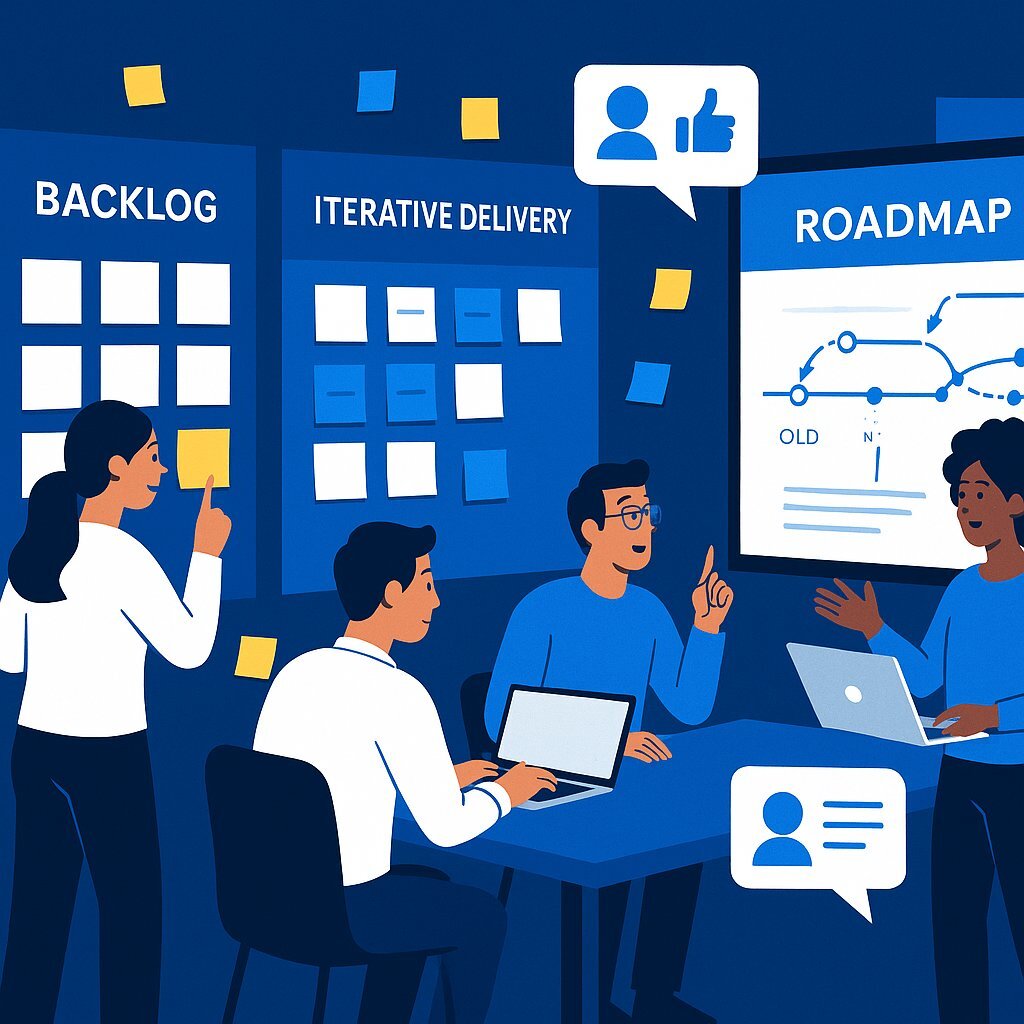
Part 4: Baytech Consulting: Your Partner in Strategic Execution
The primary challenge for most organizations lies not in creating a strategy, but in executing it. The 70% failure rate of digital transformations is a testament to the immense difficulty of bridging the gap between the boardroom vision and the market reality. Baytech Consulting is architected to be that bridge.
As a custom software development firm with deep domain expertise in the demanding sectors of finance, healthcare, advertising, and gaming , Baytech understands that technology solutions must be inextricably linked to the unique business challenges and KPIs of each industry. This industry-specific knowledge ensures that they don't just build software; they build strategic assets designed to solve specific business problems.
Baytech's approach directly enables the framework outlined in this report:
- The Tailored Tech Advantage: Off-the-shelf software is often a compromise, failing to address the specific operational nuances that create a competitive edge. Baytech's custom solutions are designed from the ground up to move the business-centric KPIs that matter most to an organization—whether that means optimizing ad delivery algorithms for an AdTech platform, streamlining patient onboarding workflows in a healthcare system, or reducing transaction latency for a FinTech company.
- Rapid Agile Deployment: This methodology is the practical application of Step 5: Iterate and Adapt with Agility. Baytech's expert teams work in agile sprints to deliver functional, value-creating software continuously. This approach allows clients to see tangible results quickly, gather real-world feedback, and adapt their strategy in response to market dynamics, ensuring that technology development remains perfectly synchronized with business objectives.
By partnering with Baytech Consulting, organizations can accelerate their transformation, mitigate execution risk, and ensure their technology investments deliver a measurable and decisive return. And for enterprises operating in fast-evolving, connected sectors, don’t overlook modern IoT and edge computing strategies—these may be the linchpin for scalable, trusted execution in energy, smart infrastructure, and beyond.
Part 5: Conclusion: Charting Your Course for Growth
The transition of IT from a cost center to a strategic partner is the defining organizational challenge of this decade. Success is not a matter of chance; it is a matter of choice and discipline. The five-step plan— Collaborative Roadmap Development, Defining Business-Centric KPIs, Justifying Investments with ROI, Continuous Communication, and Agile Adaptation —provides a proven framework for making this transformation a reality.
Ultimately, an IT roadmap is not a technical document; it is a business plan for execution in a digital world. When meticulously aligned with core business goals, it becomes one of the most powerful levers an organization can pull to drive sustainable growth, enhance profitability, and achieve definitive market leadership.
The path forward requires decisive action. The recommended next steps for executive leaders are to:
- Assess: Use this five-step framework as a lens to critically audit the organization's current IT strategy and alignment processes. Identify the gaps between current practices and this strategic ideal.
- Collaborate: Schedule a dedicated, cross-functional roadmapping workshop with the entire senior leadership team to begin the process of building a truly shared strategic vision.
- Partner: For organizations seeking to accelerate this journey and maximize the return on their technology investments, engaging a specialist partner is the logical next step. A firm like Baytech Consulting can provide the expertise, methodology, and execution capability required to turn a strategic vision into a market-leading reality.
Part 6: Further Reading
- https://www.gartner.com/en/articles/cio-challenges
- https://www.mckinsey.com/industries/industrials-and-electronics/our-insights/true-customer-centricity-an-operating-model-for-competitive-advantage
- https://www.delltechnologies.com/content/dam/uwaem/production-design-assets/india/digital-transformation/Connected_CIO_Strategy-Guide.pdf
About Baytech
At Baytech Consulting, we specialize in guiding businesses through this process, helping you build scalable, efficient, and high-performing software that evolves with your needs. Our MVP first approach helps our clients minimize upfront costs and maximize ROI. Ready to take the next step in your software development journey? Contact us today to learn how we can help you achieve your goals with a phased development approach.
About the Author

Bryan Reynolds is an accomplished technology executive with more than 25 years of experience leading innovation in the software industry. As the CEO and founder of Baytech Consulting, he has built a reputation for delivering custom software solutions that help businesses streamline operations, enhance customer experiences, and drive growth.
Bryan’s expertise spans custom software development, cloud infrastructure, artificial intelligence, and strategic business consulting, making him a trusted advisor and thought leader across a wide range of industries.


